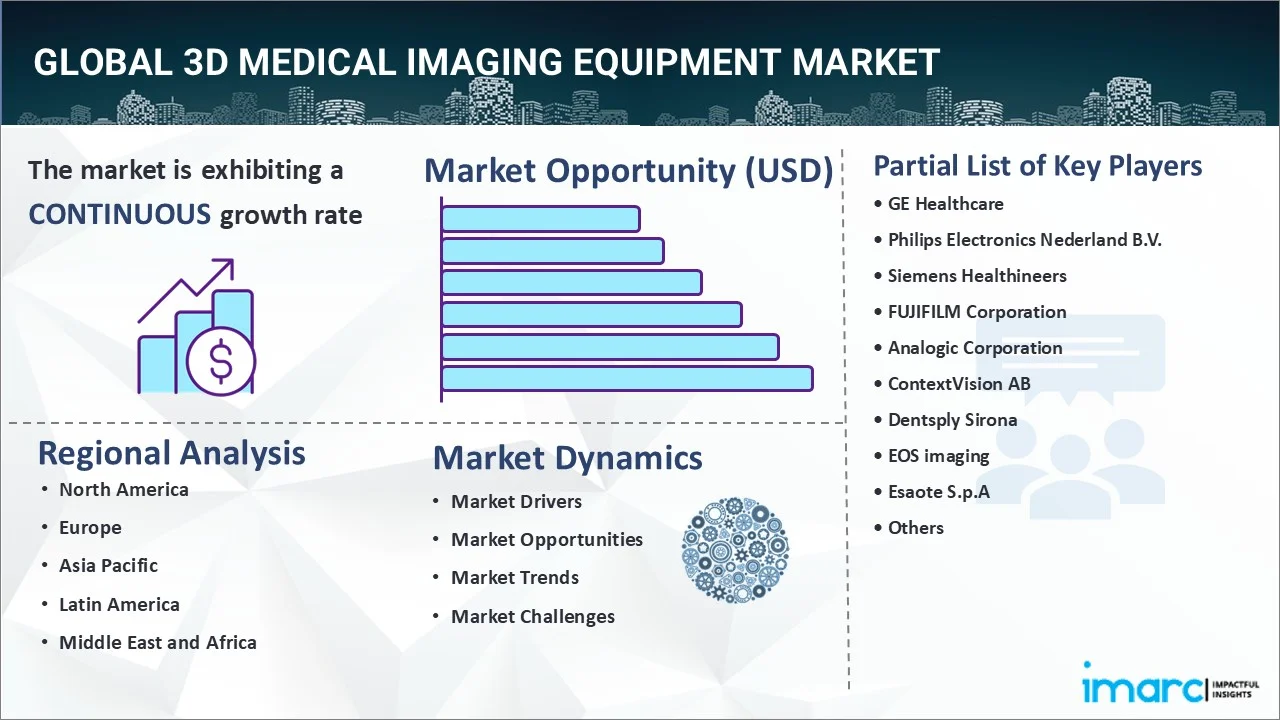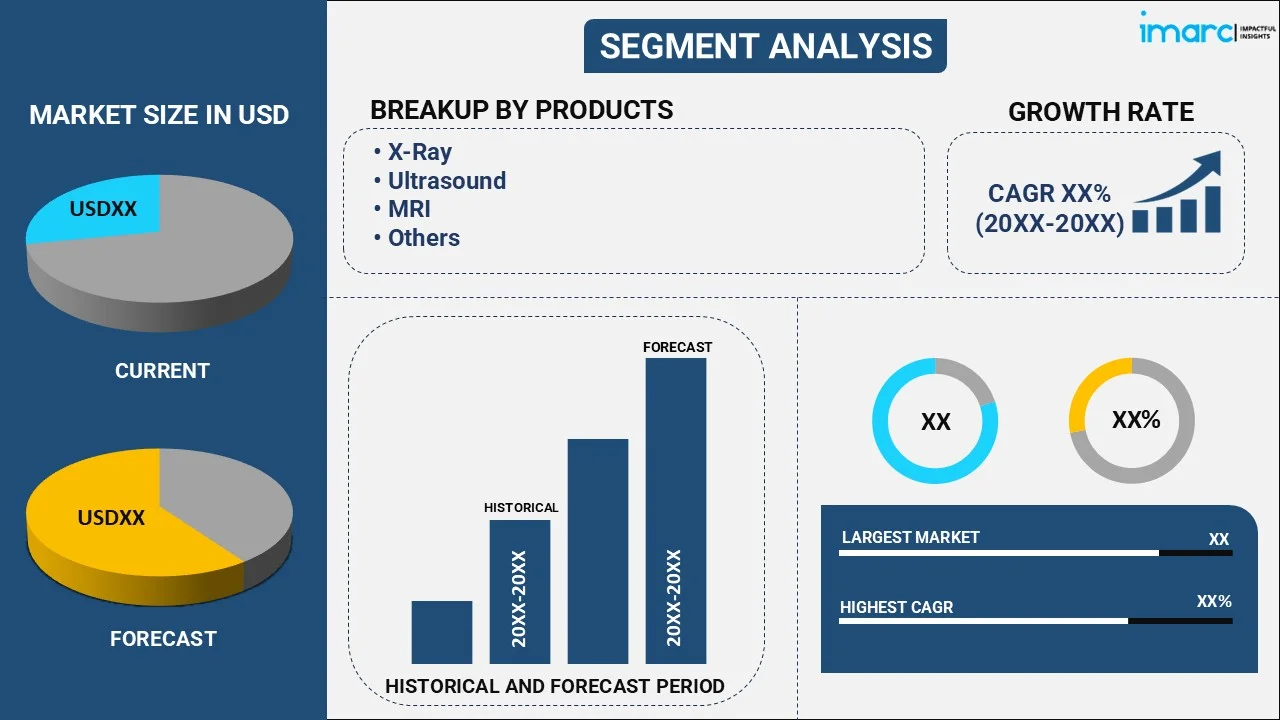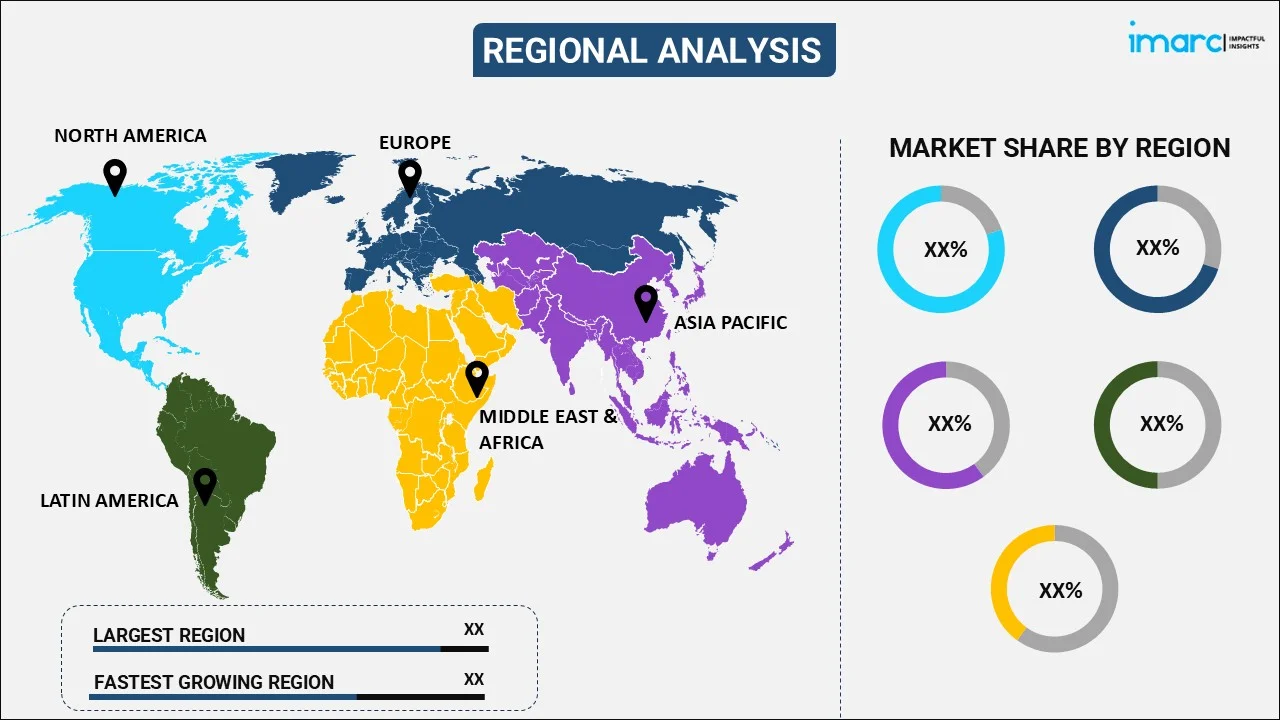
3D Medical Imaging Equipment Market Report by Product (X-Ray, Ultrasound, MRI, CT Scan, Hybrid Imaging), Solution (3D Scanning, 3D Rendering, 3D Modeling), Application (Oncology, Cardiology, Orthopedics, and Others), Component (Hardware, Software, Service), Deployment (On-Premise Based Platform, Cloud Based Platform, Web Based Platform), and Region 2025-2033
Global 3D Medical Imaging Equipment Market:
The global 3D medical imaging equipment market size reached USD 13.7 Billion in 2024. Looking forward, IMARC Group expects the market to reach USD 20.0 Billion by 2033, exhibiting a growth rate (CAGR) of 4.32% during 2025-2033. The increasing demand for better imaging solutions in healthcare is raising the adoption of advanced diagnostic tools, which is catalyzing the market.
|
Report Attribute
|
Key Statistics
|
|---|---|
|
Base Year
|
2024
|
|
Forecast Years
|
2025-2033
|
|
Historical Years
|
2019-2024
|
|
Market Size in 2024
|
USD 13.7 Billion |
|
Market Forecast in 2033
|
USD 20.0 Billion |
| Market Growth Rate 2025-2033 | 4.32% |
3D Medical Imaging Equipment Market Analysis:
- Major Market Drivers: The rising prevalence of chronic diseases leads to higher usage of imaging tools for early and accurate detection, thereby propelling the market.
- Key Market Trends: The continuous improvements in imaging technology are enhancing efficiency and accessibility, which is acting as a significant growth-inducing factor.
- Competitive Landscape: Some of the major market companies include GE Healthcare, Philips Electronics Nederland B.V., Siemens Healthineers, FUJIFILM Corporation, Analogic Corporation, ContextVision AB, Dentsply Sirona, EOS imaging, Esaote S.p.A, Fuel 3D Technologies Limited, KaVo Dental GmbH, Hologic, Inc., Intelerad Medical Systems, Planmeca Group, Samsung Medison, and Shimadzu Corporation., among many others.
- Geographical Trends: Advanced healthcare infrastructure and increased demand for diagnostic imaging solutions are augmenting the market in North America.
- Challenges and Opportunities: The complexity of data interpretation is hindering the market. However, improving software integration and user-friendly interfaces to enhance accuracy and efficiency in clinical settings will continue to strengthen the market over the forecast period.

3D Medical Imaging Equipment Market Trends:
Real-time 3D Imaging Advancements
The ability to convert 2D medical scans into dynamic 3D models in real time has significantly improved visualization for healthcare professionals. Moreover, this technology allows for faster and more accurate interpretations of complex anatomical structures, thereby optimizing clinical workflows and enhancing diagnostic accuracy. For instance, in February 2024, Visage Imaging launched Visage Ease VP, an immersive diagnostic imaging platform compatible with Apple's Vision Pro augmented reality headset. This 3D medical imaging technology enhances diagnostics through eye, hand, and voice navigation, with UC San Diego Health being the first to navigate the system.
Enhanced Precision in Surgical Procedures
3D medical imaging technology offers detailed, multi-dimensional views of anatomical structures, allowing surgeons to plan and perform procedures with greater accuracy. In contrast, this reduces risks, improves outcomes, and facilitates minimally invasive surgeries by providing a clear view of critical areas, thereby supporting more effective surgical decision-making. For instance, in June 2024, GE HealthCare and MediView launched OmnifyXR, the world's first augmented reality interventional suite, at North Star Vascular and Interventional. This 3D imaging solution offers a holographic heads-up display, 3D anatomy visualization, and remote collaboration. Thus, enhancing precision in interventional radiology procedures.
Growing Demand for Non-Invasive Diagnostics
The rise in preference for non-invasive diagnostic methods has driven the demand for 3D medical imaging equipment. Furthermore, these tools allow clinicians to conduct detailed internal examinations without requiring surgery. Therefore, offering patients safer alternatives while maintaining high levels of diagnostic detail and accuracy. For instance, in April 2024, Aura launched the Aura 3D imaging system at AMWC in Monaco. This innovative imaging solution captures a 3D digital twin of a patient's face and neck, providing AI-driven real-time skin analysis, enhancing consultations, and improving patient-practitioner communication in the imaging industry.
Global 3D Medical Imaging Equipment Industry Segmentation:
IMARC Group provides an analysis of the key trends in each segment of the market, along with the 3D medical imaging equipment market forecast at the global and regional levels for 2025-2033. Our report has categorized the market based on product, solution, application, component, and deployment.
Breakup by Product:

- X-Ray
- Ultrasound
- MRI
- CT Scan
- Hybrid Imaging
X-ray currently holds the largest 3D medical imaging equipment market share
The report has provided a detailed breakup and analysis of the market based on the product. This includes x-ray, ultrasound, MRI, CT scan, and hybrid imaging. According to the report, x-ray represented the largest market segmentation.
X-ray technology is integral to 3D medical imaging equipment, enabling precise diagnosis of complex conditions. For example, Siemens Healthineers launched the Multitom Rax, a robotic X-ray system offering advanced 3D imaging for orthopedic and trauma care.
Breakup by Solution:
- 3D Scanning
- 3D Rendering
- 3D Modeling
3D rendering currently holds the largest 3D medical imaging equipment market demand
The report has provided a detailed breakup and analysis of the market based on the solution. This includes 3D scanning, 3D rendering, and 3D modeling. According to the report, 3D rendering represented the largest market segmentation.
3D rendering in medical imaging equipment transforms scan data into detailed visuals, aiding diagnostics and surgical planning. For example, GE Healthcare's Revolution CT introduced real-time, high-resolution 3D imaging, thereby enhancing clinical accuracy for complex procedures like cardiac assessments.
Breakup by Application:
- Oncology
- Cardiology
- Orthopedics
- Others
Oncology currently holds the largest 3D medical imaging equipment market statistics
The report has provided a detailed breakup and analysis of the market based on the application. This includes oncology, cardiology, orthopedics, and others. According to the report, oncology represented the largest market segmentation.
3D medical imaging equipment in oncology enhances tumor detection, treatment planning, and monitoring. For example, Siemens' Biograph Vision Quadra PET/CT system revolutionizes cancer diagnosis, providing ultra-high resolution and extended field-of-view imaging for precision care.
Breakup by Component:
- Hardware
- Software
- Service
Hardware currently holds the largest 3D medical imaging equipment market revenue
The report has provided a detailed breakup and analysis of the market based on the component. This includes hardware, software, and service. According to the report, hardware represented the largest market segmentation.
Hardware in 3D medical imaging equipment includes advanced components like sensors, processors, and scanners, enhancing image quality and precision. For example, Siemens Healthineers launched the Artis icono, a 3D medical imaging system featuring advanced hardware components. This innovation boosts image clarity, enhancing accuracy in diagnostics and aiding complex medical procedures with greater efficiency.
Breakup by Deployment:
- On-Premise Based Platform
- Cloud Based Platform
- Web Based Platform
On-premise based platform currently holds the largest 3D medical imaging equipment market outlook
The report has provided a detailed breakup and analysis of the market based on the deployment. This includes on-premise based platform, cloud based platform, and web based platform. According to the report, on-premise based platform represented the largest market segmentation.
On-premise deployment of 3D medical imaging equipment allows hospitals to maintain control over data security and compliance. For example, Siemens Healthineers launched the ARTIS icono, enhancing on-premise imaging systems for precision in complex interventional procedures.
Breakup by Region:

- North America
- Europe
- Asia Pacific
- Middle East and Africa
- Latin America
North America dominates the market
The market research report has also provided a comprehensive analysis of all the major regional markets, which include North America, Europe, Asia Pacific, Middle East and Africa, and Latin America. According to the report, North America accounted for the largest market share.
North America leads the market due to its advanced healthcare infrastructure, high adoption of cutting-edge technologies, and strong R&D investments. In addition, the region's leadership is further supported by increasing demand for accurate diagnostics and government support for innovation in medical imaging, keeping it at the forefront of this sector globally. Furthermore, GE Healthcare's launch of the Revolution Ascend enhanced diagnostic precision with AI-powered imaging. Consequently, these factors mark the region's dominance in the market.
Competitive Landscape:
The 3D medical imaging equipment market research report has provided a comprehensive analysis of the competitive landscape. Detailed profiles of all major market companies have also been provided. Some of the key players in the market include:
- GE Healthcare
- Philips Electronics Nederland B.V.
- Siemens Healthineers
- FUJIFILM Corporation
- Analogic Corporation
- ContextVision AB
- Dentsply Sirona
- EOS imaging
- Esaote S.p.A
- Fuel 3D Technologies Limited
- KaVo Dental GmbH
- Hologic, Inc.
- Intelerad Medical Systems
- Planmeca Group
- Samsung Medison
- Shimadzu Corporation
(Please note that this is only a partial list of the key players, and the complete list is provided in the report.)
3D Medical Imaging Equipment Market Recent Developments:
- May 2024: Novius launched N-Vision 3D, an AI-powered 3D medical imaging equipment technology that supports existing endoscopes without modification and integrates NVIDIA GPU for rapid conversion at 0.008 seconds.
- April 2024: Aura introduced the Aura 3D imaging system at AMWC in Monaco. This imaging solution captures a 3D digital twin of a patient’s face and neck, providing AI-driven real-time skin analysis, enhancing consultations, and improving patient-practitioner communication.
- January 2024: Norwegian startup HoloCare launched its AI-powered 3D surgical hologram technology across the UK and Europe, which is certified by UKCA and CE. This platform enhances pre-surgical planning by creating interactive 3D holograms, improving precision in complex surgeries, starting with liver resections.
3D Medical Imaging Equipment Market Report Scope:
| Report Features | Details |
|---|---|
| Base Year of the Analysis | 2024 |
| Historical Period | 2019-2024 |
| Forecast Period | 2025-2033 |
| Units | Billion USD |
| Scope of the Report | Exploration of Historical Trends and Market Outlook, Industry Catalysts and Challenges, Segment-Wise Historical and Predictive Market Assessment:
|
| Products Covered | X-Ray, Ultrasound, MRI, CT Scan, Hybrid Imaging |
| Solutions Covered | 3D Scanning, 3D Rendering, 3D Modeling |
| Applications Covered | Oncology, Cardiology, Orthopedics, Others |
| Components Covered | Hardware, Software, Service |
| Deployments Covered | On-Premise Based Platform, Cloud Based Platform, Web Based Platform |
| Regions Covered | Asia Pacific, Europe, North America, Latin America, Middle East and Africa |
| Companies Covered | GE Healthcare, Philips Electronics Nederland B.V., Siemens Healthineers, FUJIFILM Corporation, Analogic Corporation, ContextVision AB, Dentsply Sirona, EOS imaging, Esaote S.p.A, Fuel 3D Technologies Limited, KaVo Dental GmbH, Hologic, Inc., Intelerad Medical Systems, Planmeca Group, Samsung Medison, Shimadzu Corporation, etc. |
| Customization Scope | 10% Free Customization |
| Post-Sale Analyst Support | 10-12 Weeks |
| Delivery Format | PDF and Excel through Email (We can also provide the editable version of the report in PPT/Word format on special request) |
Key Benefits for Stakeholders:
- IMARC's industry report offers a comprehensive quantitative analysis of various market segments, historical and current market trends, market forecasts, and dynamics of the 3D medical imaging equipment market from 2019-2033.
- The research report provides the latest information on the market drivers, challenges, and opportunities in the global 3D medical imaging equipment market.
- The study maps the leading, as well as the fastest-growing, regional markets.
- Porter's five forces analysis assists stakeholders in assessing the impact of new entrants, competitive rivalry, supplier power, buyer power, and the threat of substitution. It helps stakeholders to analyze the level of competition within the 3D medical imaging equipment industry and its attractiveness.
- The competitive landscape allows stakeholders to understand their competitive environment and provides insight into the current positions of key players in the market.
Key Questions Answered in This Report
The global 3D medical imaging equipment market was valued at USD 13.7 Billion in 2024.
We expect the global 3D medical imaging equipment market to exhibit a CAGR of 4.32% during 2025-2033.
The rising awareness towards the benefits of 3D medical imaging equipment technology, such as an accurate visual representation of internal organs, reduced damage to surrounding tissues, and accuracy of data offered by various medical imaging procedures, is primarily driving the 3D medical imaging equipment market.
The sudden outbreak of the COVID-19 pandemic has led to the increasing adoption of 3D medical imaging equipment during the diagnosis of ailments that are caused by recovering from the coronavirus infection.
Based on the product, the global 3D medical imaging equipment market can be segmented into x-ray, ultrasound, MRI, CT scan, and hybrid imaging, where x-ray currently accounts for the largest market share.
Based on the solution, the global 3D medical imaging equipment market has been divided 3D scanning, 3D rendering, and 3D modeling. Currently, 3D rendering exhibits a clear dominance in the market.
Based on the application, the global 3D medical imaging equipment market can be categorized into oncology, cardiology, orthopedics, and others. Among these, oncology currently holds the majority of the total market share.
Based on the component, the global 3D medical imaging equipment market has been segregated into hardware, software, and service. Currently, hardware exhibits a clear dominance in the market.
Based on the deployment, the global 3D medical imaging equipment market can be bifurcated into on-premise based platform, cloud based platform, and web based platform. Among these, on-premise based platform accounts for the majority of the total market share.
On a regional level, the market has been classified into North America, Europe, Asia Pacific, Middle East and Africa, and Latin America, where North America currently dominates the global market.
Some of the major players in the global 3D medical imaging equipment market include GE Healthcare, Philips Electronics Nederland B.V., Siemens Healthineers, FUJIFILM Corporation, Analogic Corporation, ContextVision AB, Dentsply Sirona, EOS imaging, Esaote S.p.A, Fuel 3D Technologies Limited, KaVo Dental GmbH, Hologic, Inc., Intelerad Medical Systems, Planmeca Group, Samsung Medison, and Shimadzu Corporation.
Need more help?
- Speak to our experienced analysts for insights on the current market scenarios.
- Include additional segments and countries to customize the report as per your requirement.
- Gain an unparalleled competitive advantage in your domain by understanding how to utilize the report and positively impacting your operations and revenue.
- For further assistance, please connect with our analysts.
 Inquire Before Buying
Inquire Before Buying
 Speak to an Analyst
Speak to an Analyst
 Request Brochure
Request Brochure
 Request Customization
Request Customization




.webp)




.webp)












